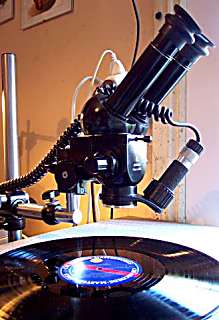 |
Applied Microscopy. The Microscopy of Vinyl Recordings. Examining the Grooves. |
Page 2 of 4 |
 |
Applied Microscopy. The Microscopy of Vinyl Recordings. Examining the Grooves. |
Page 2 of 4 |
 When faced with the task of identifying the cause of an obstinate click on a vinyl record which cannot be removed by brushing with a carbon fibre brush or by prodding with stiffer nylon bristles, the following procedure is recommended.
When faced with the task of identifying the cause of an obstinate click on a vinyl record which cannot be removed by brushing with a carbon fibre brush or by prodding with stiffer nylon bristles, the following procedure is recommended.
Before removing the record from the turntable, visually locate the source of the click by noting the position of the record label in relation to the stylus, and how far the stylus is in from the edge of the record. Use a hand magnifier of x6 to x10 to examine the area. This will quite often be enough to give a clear idea of the cause of the problem. If closer examination is needed, the setup shown in the picture on the right is useful. A low power stereo microscope with its own illumination, suspended on an adjustable arm over a suitably large piece of foam plastic should enable the record to be positioned and manipulated without risk of damage. Beware of using too high an intensity of illumination if the lamp concentrates the light from a tungsten filament lamp onto the record, as local heating may cause a warp in the record surface. Use low power to locate the obstacle, and higher powers as required. Swing the lamp around on its pivot to illuminate the area from different directions as the grooves catch the light and cause reflections which may be confusing if the left and right eyes see markedly different images. The following image is of a mono recording, photographed using an epi-illumination setup in which the incident light is directed onto the record surface by a system of annular reflectors concentric with the x21 power objective, producing an incident light darkfield. Total magnification is x300. 
A mono vinyl record in epi-illumination darkfield. X300. The image below is of a fairly heavily modulated (loud) section of a stereo record, and has been photographed in incident brightfield -- an arrangement whereby the illumination is directed down through the objective, which acts as its own condenser as well as producing the image. Magnification is x400. The light coloured areas of the picture is the flat record surface -- the land between the grooves. The grooves themselves are more complex than in the mono record due to the fact that one wall of the groove produces the right stereo channel, and the other wall produces the left. 
A stereo vinyl record in epi-illumination brightfield. x400. The picture also shows a lip or burr of vinyl which extends slightly above the record surface along the upper edge of both sides of the groove. It explains the strange phenomenon known only to owners of a light-tracking cartridge and a well balanced, bias compensated tone arm, whereby the stylus tracks the record by running on the land between the grooves, requiring a nudge to drop it into the groove. The burrs are an artefact of the lacquer-cutting stage of record production, and are called "horns" in the trade. They are faithfully reproduced through all subsequent stages of manufacture. The technique of cutting the lacquer master with a heated stylus largely eliminated this phenomenon, and the example shown here is probably due to non-optimum heating of the engraving stylus. They do not directly affect the sound produced by the record, but they are fragile, and if the record surface is lightly scraped or rubbed, they can overhang the groove, causing noisy playback. |